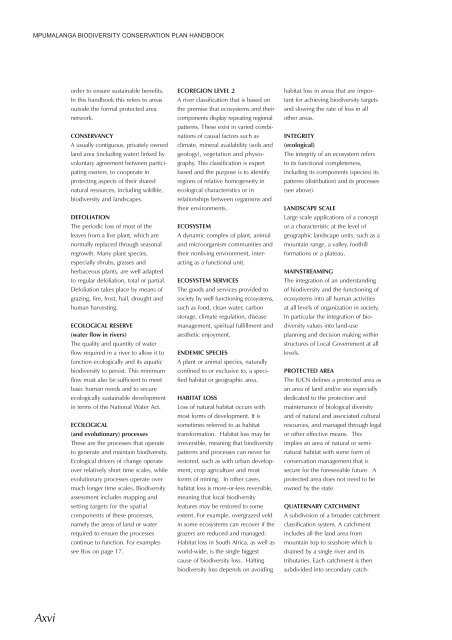Mpumalanga Biodiversity Conservation Plan Handbook - bgis-sanbi
Mpumalanga Biodiversity Conservation Plan Handbook - bgis-sanbi
Mpumalanga Biodiversity Conservation Plan Handbook - bgis-sanbi
Create successful ePaper yourself
Turn your PDF publications into a flip-book with our unique Google optimized e-Paper software.
MPUMALANGA BIODIVERSITY CONSERVATION PLAN HANDBOOK<br />
Axvi<br />
order to ensure sustainable benefits.<br />
In this handbook this refers to areas<br />
outside the formal protected area<br />
network.<br />
CONSERVANCY<br />
A usually contiguous, privately owned<br />
land area (including water) linked by<br />
voluntary agreement between participating<br />
owners, to cooperate in<br />
protecting aspects of their shared<br />
natural resources, including wildlife,<br />
biodiversity and landscapes.<br />
DEFOLIATION<br />
The periodic loss of most of the<br />
leaves from a live plant, which are<br />
normally replaced through seasonal<br />
regrowth. Many plant species,<br />
especially shrubs, grasses and<br />
herbaceous plants, are well adapted<br />
to regular defoliation, total or partial.<br />
Defoliation takes place by means of<br />
grazing, fire, frost, hail, drought and<br />
human harvesting.<br />
ECOLOGICAL RESERVE<br />
(water flow in rivers)<br />
The quality and quantity of water<br />
flow required in a river to allow it to<br />
function ecologically and its aquatic<br />
biodiversity to persist. This minimum<br />
flow must also be sufficient to meet<br />
basic human needs and to secure<br />
ecologically sustainable development<br />
in terms of the National Water Act.<br />
ECOLOGICAL<br />
(and evolutionary) processes<br />
These are the processes that operate<br />
to generate and maintain biodiversity.<br />
Ecological drivers of change operate<br />
over relatively short time scales, while<br />
evolutionary processes operate over<br />
much longer time scales. <strong>Biodiversity</strong><br />
assessment includes mapping and<br />
setting targets for the spatial<br />
components of these processes,<br />
namely the areas of land or water<br />
required to ensure the processes<br />
continue to function. For examples<br />
see Box on page 17.<br />
ECOREGION LEVEL 2<br />
A river classification that is based on<br />
the premise that ecosystems and their<br />
components display repeating regional<br />
patterns. These exist in varied combinations<br />
of causal factors such as<br />
climate, mineral availability (soils and<br />
geology), vegetation and physiography.<br />
This classification is expert<br />
based and the purpose is to identify<br />
regions of relative homogeneity in<br />
ecological characteristics or in<br />
relationships between organisms and<br />
their environments.<br />
ECOSYSTEM<br />
A dynamic complex of plant, animal<br />
and microorganism communities and<br />
their nonliving environment, interacting<br />
as a functional unit.<br />
ECOSYSTEM SERVICES<br />
The goods and services provided to<br />
society by well functioning ecosystems,<br />
such as food, clean water, carbon<br />
storage, climate regulation, disease<br />
management, spiritual fulfillment and<br />
aesthetic enjoyment.<br />
ENDEMIC SPECIES<br />
A plant or animal species, naturally<br />
confined to or exclusive to, a specified<br />
habitat or geographic area.<br />
HABITAT LOSS<br />
Loss of natural habitat occurs with<br />
most forms of development. It is<br />
sometimes referred to as habitat<br />
transformation. Habitat loss may be<br />
irreversible, meaning that biodiversity<br />
patterns and processes can never be<br />
restored, such as with urban development,<br />
crop agriculture and most<br />
forms of mining. In other cases,<br />
habitat loss is more-or-less reversible,<br />
meaning that local biodiversity<br />
features may be restored to some<br />
extent. For example, overgrazed veld<br />
in some ecosystems can recover if the<br />
grazers are reduced and managed.<br />
Habitat loss in South Africa, as well as<br />
world-wide, is the single biggest<br />
cause of biodiversity loss. Halting<br />
biodiversity loss depends on avoiding<br />
habitat loss in areas that are important<br />
for achieving biodiversity targets<br />
and slowing the rate of loss in all<br />
other areas.<br />
INTEGRITY<br />
(ecological)<br />
The integrity of an ecosystem refers<br />
to its functional completeness,<br />
including its components (species) its<br />
patterns (distribution) and its processes<br />
(see above).<br />
LANDSCAPE SCALE<br />
Large scale applications of a concept<br />
or a characteristic at the level of<br />
geographic landscape units, such as a<br />
mountain range, a valley, foothill<br />
formations or a plateau.<br />
MAINSTREAMING<br />
The integration of an understanding<br />
of biodiversity and the functioning of<br />
ecosystems into all human activities<br />
at all levels of organization in society.<br />
In particular the integration of biodiversity<br />
values into land-use<br />
planning and decision making within<br />
structures of Local Government at all<br />
levels.<br />
PROTECTED AREA<br />
The IUCN defines a protected area as<br />
an area of land and/or sea especially<br />
dedicated to the protection and<br />
maintenance of biological diversity<br />
and of natural and associated cultural<br />
resources, and managed through legal<br />
or other effective means. This<br />
implies an area of natural or seminatural<br />
habitat with some form of<br />
conservation management that is<br />
secure for the foreseeable future. A<br />
protected area does not need to be<br />
owned by the state.<br />
QUATERNARY CATCHMENT<br />
A subdivision of a broader catchment<br />
classification system. A catchment<br />
includes all the land area from<br />
mountain top to seashore which is<br />
drained by a single river and its<br />
tributaries. Each catchment is then<br />
subdivided into secondary catch-

















